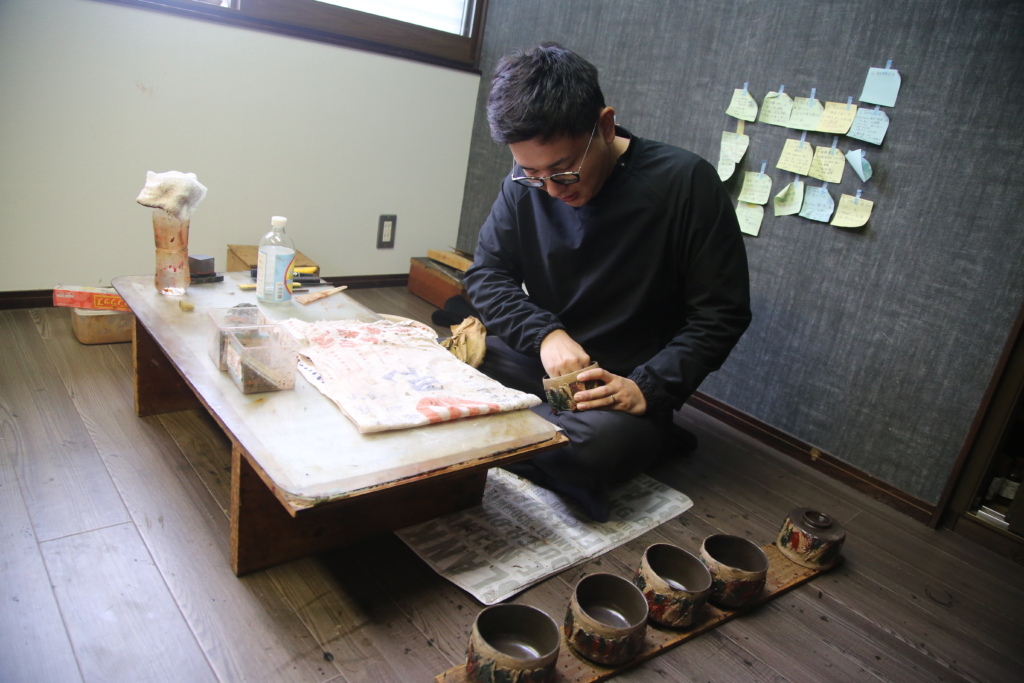
From a Studio in the Mountains to the World Exploring New Frontiers of Wajima Lacquer with Innovative Techniques
Nestled in the mountains of Wajima City, Ishikawa Prefecture, “Wajima-nuri Studio RAKU” is a family-run workshop that strives to preserve traditional Wajima lacquer techniques while exploring new possibilities. We spoke with Kazuyori and Tamao Hikimochi, who lead the workshop, about the history of the studio, the artisans’ dedication to their craft, and their connection to the local community.
The History of the Workshop and the Meaning Behind Its Name
The history of the workshop began in 1983 when Rikio Hikimochi, after years of training, decided to go independent. After graduating from high school, Rikio Hikimochi became an apprentice at a lacquer workshop in Wajima City, where he rigorously learned the technique of high-quality lacquer application. Eventually, he became a full-fledged craftsman, mastering the skills needed for the entire process, from preparing the base to the final lacquer coating. This ability to handle the entire process was rare in the division of labor typical in Wajima lacquer, and it became a key strength of the workshop, rooted in Rikio’s skills and aspirations.
In the early days of his independent business, the Japanese economy was booming during the bubble period, and the business was progressing smoothly. While utilizing traditional Wajima lacquer techniques, Rikio Hikimochi’s products gained the support of many customers, and the foundation for the workshop was gradually established. However, when the bubble economy burst in 1988, the effects quickly reached the Wajima lacquer market. Facing declining sales and shrinking clientele, the workshop was thrust into a difficult situation.
Despite these challenges, the family united to protect the workshop. Tamao Hikimochi took charge of sales, public relations, and planning while supporting Rikio’s techniques, and their son, Kazuyori Hikimochi, gradually gained experience. In 2019, Kazuyori Hikimochi officially took over the workshop, embarking on a new path of challenges.
The name of the workshop, “RAKU,” was inspired by a comment from a customer, who remarked, “This lacquer is so enjoyable.” The word “raku” carries multiple meanings, including “fun” in Japanese, as well as echoes of the English word “luck” and the French word “laque” (lacquer). It embodies the desire to express the joy and fortune that lacquer can bring. Additionally, the name carries the hope that “things made with lacquer will bring happiness to those who use them.”
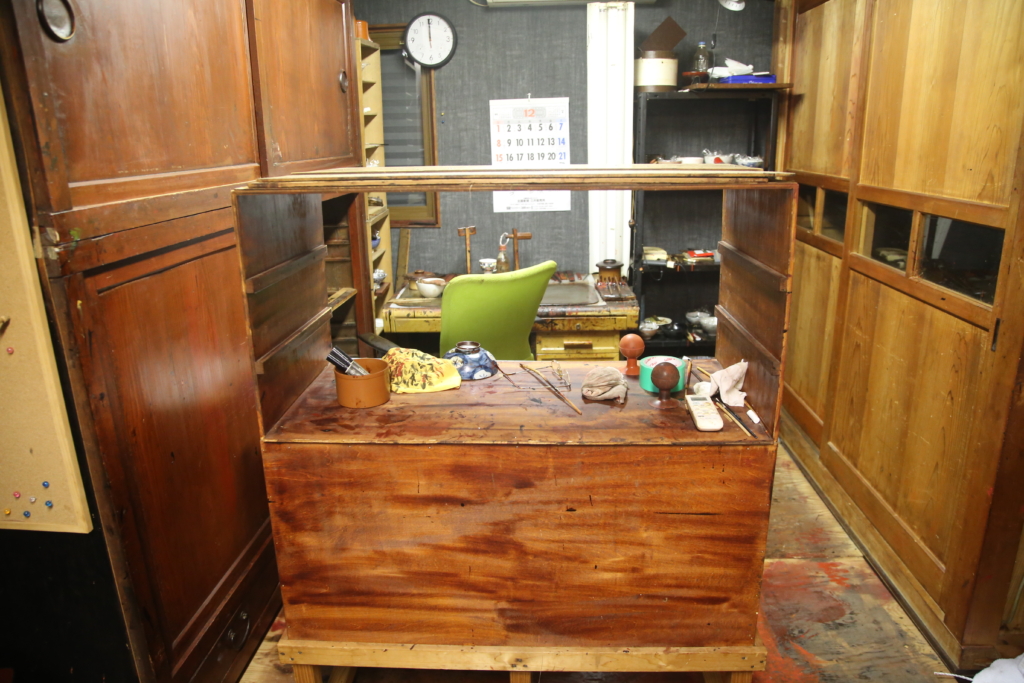
The Path to Becoming a Craftsman, a Passion for Repair, and Preserving Tradition
Kazuyori Hikimochi’s decision to become a craftsman was clear-cut. “There were no other options,” he says matter-of-factly, but this simplicity stems from his upbringing in the workshop. When asked about his childhood impressions, he laughs and recalls, “I thought it was quite a profitable job. When I heard that expensive items were selling, that’s how it seemed to me.” However, as he gained hands-on experience in the craft, he came to fully understand the difficulty and value of making things by hand.
His first encounter with lacquer came during high school, and by the age of 20, he was committed to becoming a craftsman. Before learning Wajima lacquer techniques, he trained under a Buddhist altar craftsman in the nearby city of Nanao, where he mastered the technique of applying gold leaf called “Nuri-haku.” This experience later led him to develop his own unique technique, “Kyara-nuri.”
Around 90% of Kazuyori’s work is focused on repair. “I have a strong desire to properly restore items that are precious to customers,” he says. His repair work spans not only Wajima lacquer but also various items such as plastic lacquerware, all of which hold personal memories for the customers. “When I’m asked to fix something that’s been passed down from a grandmother, I take that sentiment to heart and approach the repair with great care.”
One of the most memorable repair projects was the “Karatsu Kunchi Festival” float restoration project, which he worked on four years ago. He was deeply moved by the passionate feelings of the people involved in the festival and said, “I felt that I had made the right choice in pursuing this career.” Reflecting on that experience, he added, “I want to continue using my skills for the people who have such strong, heartfelt dedication.”
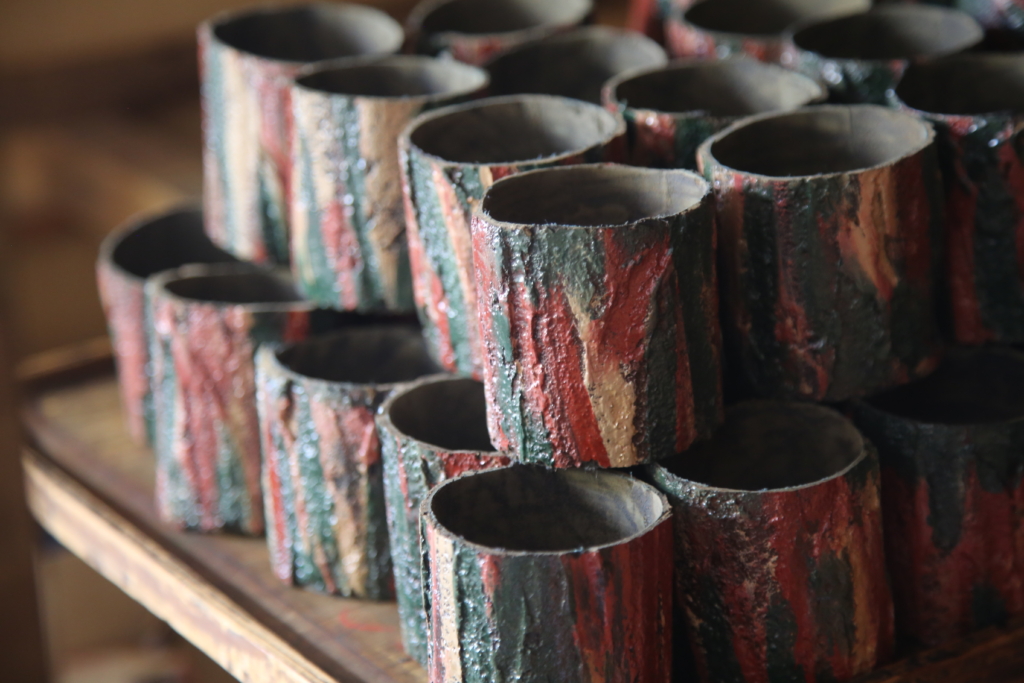
A New Challenge to the World with the Innovative “Kyara-nuri” Technique
Kazuyori Hikomachi continues to push the boundaries of Wajima lacquer by incorporating new techniques and values. One of his most notable achievements is the creation of a technique known as “Kyara-nuri.” In this method, silver leaf is applied over the traditional Wajima lacquer base, and the surface of the silver leaf is then scraped with a thin tool, resembling a bamboo skewer, to create patterns. Afterward, a high-transparency white lacquer is applied in multiple layers, not only securing the leaf but also creating a unique beauty where the depth of the lacquer harmonizes with the shine of the silver leaf. When light hits the piece, the pattern emerges, showing different expressions depending on the angle, offering a new possibility that is absent in traditional Wajima lacquer.
The development of Kyara-nuri was a process of trial and error. “The idea of applying lacquer over processed silver leaf was new, but when I tried it, I kept failing,” Kazuyori explains. However, through continuous trial and error, he gradually figured out the techniques, improving the quality of the work. “Establishing a new technique became a weapon for me as a craftsman. I had a strong desire not to lose,” he says, emphasizing his passion.
Kazuyori’s new technique has been highly praised both domestically and internationally. In 2020, he was selected for the Ishikawa International Urushi Exhibition, where his skill and expressiveness were recognized. His Kyara-nuri works were also selected for the prestigious “Homo Faber” exhibition in Venice, Italy, a global event showcasing craftsmanship. At the exhibition, many visitors stopped in front of his pieces, marveling at their beauty. Comments like “It’s beautiful” and “I’ve never seen such a shine” were a great encouragement to the family.
“Wajima lacquer is a high-quality, beautiful product, but opportunities to showcase its charm are limited,” says his mother, Tamao. While the value of this traditional craft is clear, she hopes that by allowing people to see the meticulous process of creation, more people will come to understand the deep beauty and cultural significance that Wajima lacquer holds.
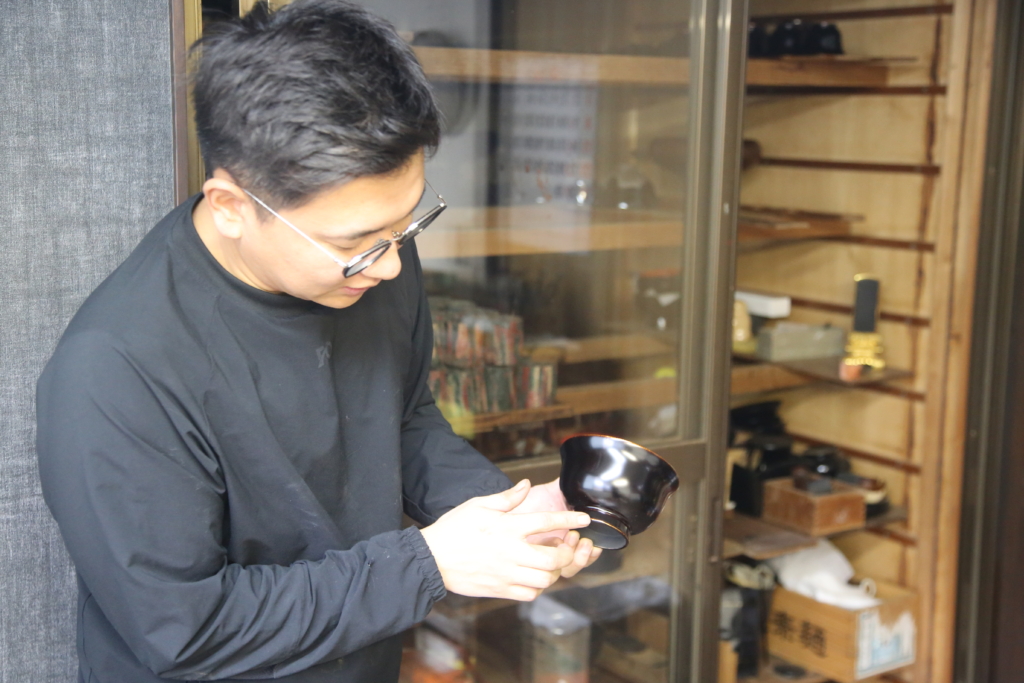
Thoughts as a Young Craftsman and Vision for the Future
Kazuyori Hikomachi feels the challenge of not having craftsmen in the same generation in the world of Wajima lacquer. “There aren’t many makers, and it’s lonely not having peers of my own generation,” he says, but at the same time, he maintains a positive outlook, adding, “I’m the type who enjoys quietly working, so this job is a perfect fit for me.” While repetitive tasks allow him to concentrate, working on repairs for individual customers requires more delicate handling, as each item’s shape and condition differ. However, he believes, “To meet the customer’s expectations, it’s important to approach each piece with care.”
Kazuyori envisions his future as a craftsman, stating, “I don’t want to be a one-hit wonder; I want to be a long-lasting craftsman.” He is determined, saying, “I plan to continue until I can no longer see. Until then, I will keep working hard,” reflecting his strong will to preserve tradition while passing on his skills to the next generation.
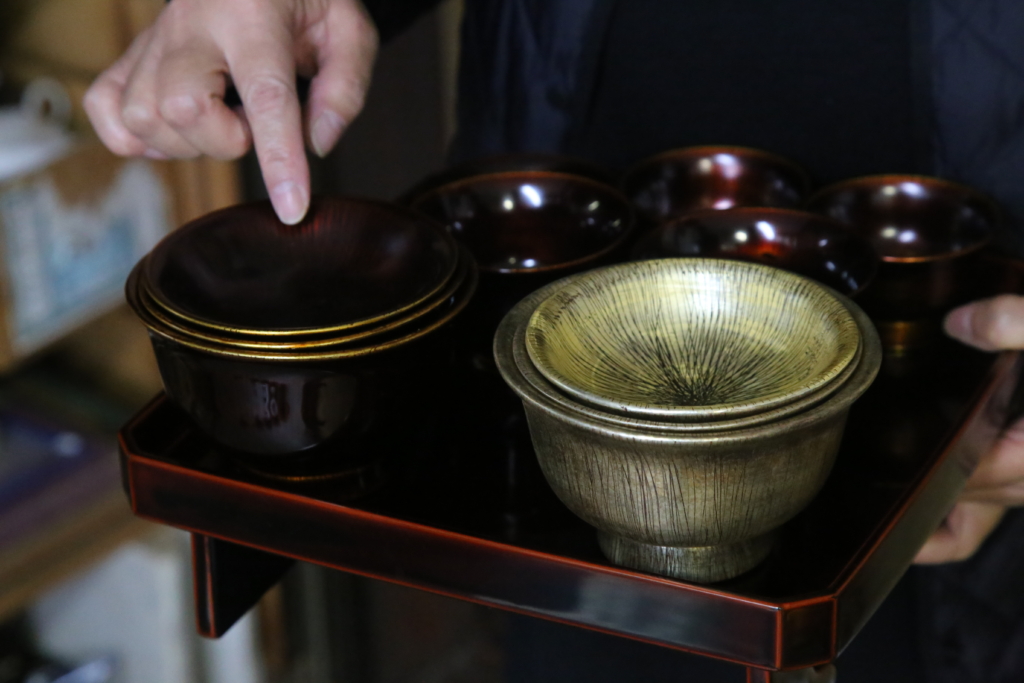
Life in the Countryside of Noto
The studio is located in the satoyama (mountainous rural) area of Noto, a region rich in nature, designated as an agricultural heritage site. However, due to the effects of earthquakes and depopulation, the sight of abandoned rice fields has become more common. Tamao Hikimochi, working in collaboration with local residents, has started new initiatives to address this.
“This region once had a traditional landscape of rice fields, and when I saw that disappearing, I felt a strong urge to do something about it,” Tamao shares. With the support of local people, she is preparing for rice planting next spring.
“By restoring the golden-colored rice fields, I hope the people living here can once again feel the richness of the area. I also want to create a place where those who have left Wajima can feel, ‘I want to come back,’” she says, filled with a desire to revitalize the entire region. Protecting the local traditions and landscape is closely connected to the activities of the workshop.
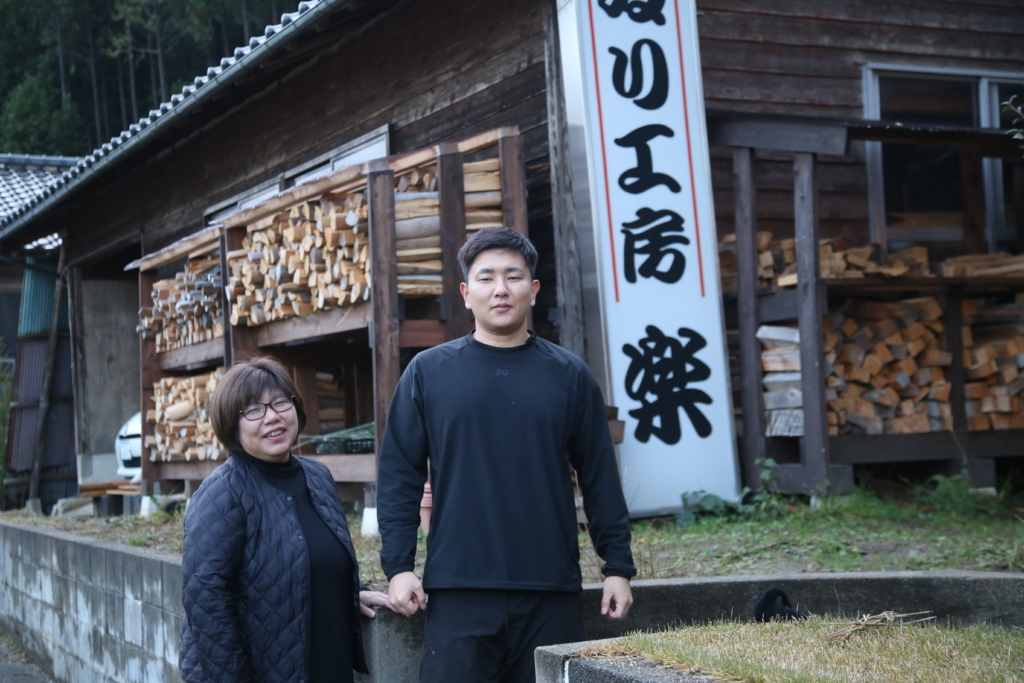
The Vision of “Wajima-nuri Studio RAKU”
Tamao Hikimochi expresses a strong desire to one day resume a hands-on experience program that was interrupted due to earthquake damage. The program was designed to allow visitors to observe the craftsmanship up close and experience the process of creating Wajima lacquerware. The aim was to give visitors a direct experience of the unique beauty of lacquer and the intricate craftsmanship and effort hidden behind it, helping them understand the true value of Wajima lacquer.
“Lacquerware often has the image of being expensive and inaccessible,” Tamao explains. “However, the price reflects the immense effort, attention to detail, and skill that go into it. If people understand this, they will appreciate its value.” Her words reflect a deep commitment to preserving Wajima lacquer as a high-quality, sustainable craft for future generations.
Kazuyori, reflecting on his own experiences during his training, offers advice to younger craftsmen: “It’s important not to give up and not let yourself get discouraged. Once you lose heart, it becomes difficult to continue. So, I want them to aim for a steady, long-lasting career, even if it means working at 60% of their capacity without overdoing it.”
“Wajima-nuri Studio RAKU” continues to pursue new values while preserving the tradition of Wajima lacquer. Their efforts go beyond just creating products; they contribute to enriching Japan’s culture and the future of the local community. The family’s collective strength, determination, and willingness to take on challenges inspire and give hope to many people.
Kazuyori Hikimochi
Born in 1994. The second-generation Wajima-nuri craftsman at “Wajima-nuri Studio RAKU” in Wajima City, Ishikawa Prefecture. Raised by watching his father, the first-generation craftsman Rikio Hikimochi, he naturally followed the path of craftsmanship. He studied sculpture at Kyoto Arts and Crafts University. He became an apprentice to a Buddhist altar craftsman in Nanao City, a neighboring area of Noto, where he learned the traditional technique of applying gold leaf called “Nuri-haku.” After gaining experience in cultural heritage restoration, he developed a new Wajima-nuri technique called “Kyara-nuri.”
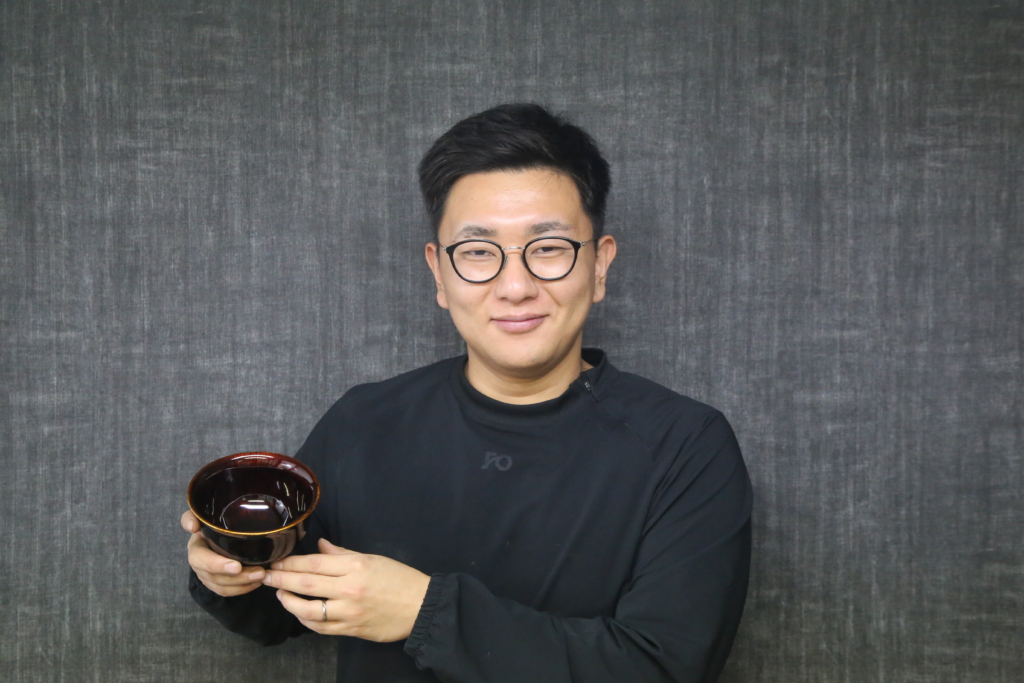
If you would like to visit Wajima Nuri and get further into the world of Wajima Nuri, please see the following information
From a mountain workshop in Noto to the world
Wajima-nuri Raku workshop tour
Highlights
・You can tour the workshop with a Wajima-nuri craftsman.
・You can see Kyara-nuri and KOKEMUSU in the gallery.
Information
Price: from 4,000 yen per person
Participants: 1 to 6 people
Duration: about 1 hour
Included: Tour of Miyakichi pottery workshop
Meeting: Wajima Nuri Nuri Kobo Raku
Language: Japanese (English interpreter can be arranged upon request)
For reservation inquiries, please click here.